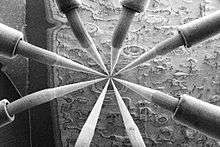Nanoprobing
Nanoprobing is method of extracting device electrical parameters through the use of nanoscale tungsten wires, used primarily in the semiconductor industry. The characterization of individual devices is instrumental to engineers and integrated circuit designers during initial product development and debug. It is commonly utilized in device failure analysis laboratories to aid with yield enhancement, quality and reliability issues and customer returns. Commercially available nanoprobing systems are integrated into either a vacuum-based scanning electron microscope (SEM) or atomic force microscope (AFM). Nanoprobing systems that are based on AFM technology are referred to as Atomic Force nanoProbers (AFP).
Principles and operation
AFM based nanoprobers, enable up to eight probe tips to be scanned to generate high resolution AFM topography images, as well as Conductive AFM, Scanning Capacitance, and Electrostatic Force Microscopy images. Conductive AFM provides pico-amp resolution to identify and localize electrical failures such as shorts, opens, resistive contacts and leakage paths, enabling accurate probe positioning for current-voltage measurements. AFM based nanoprobers enable nanometer scale device defect localization and accurate transistor device characterization without the physical damage and electrical bias induced by high energy electron beam exposure.


For SEM based nanoprobers, the ultra-high resolution of the microscopes that house the nanoprobing system allow the operator to navigate the probe tips with precise movement, allowing the user to see exactly where the tips will be landed, in real time. Existing nanoprobe needles or “probe tips” have a typical end-point radius ranging from 5 to 35 nm.[1] The fine tips enable access to individual contacts nodes of modern IC transistors. Navigation of the probe tips in SEM based nanoprobers are typically controlled by precision piezoelectric manipulators. Typical systems have anywhere from 2 to 8 probe manipulators with high end tools having better than 5 nm of placement resolution in the X, Y & Z axes and a high accuracy sample stage for navigation of the sample under test.
Application and capabilities for semiconductor devices


Common nanoprobing techniques include, but are not limited to:
- Conductive Atomic Force Microscopy (CAFM) - only available in AFM based tools
- Scanning Capacitance Microscopy (SCM) - only available in AFM based tools
- Electrostatic Force Microscopy (EFM) - only available in AFM based tools
- DC transistor characterization (Id-Vg and Id-Vd Measurements)[2][3]
- Characterizing SRAM bitcells[4][5]
- BEOL Metal Resistance Measurements
- Electron-Beam Absorbed Current Imaging (EBAC)[6][7] - only available in SEM based tools
Challenges
Common issues that arise:
- Nanoprobe manipulator stability[8]
- Live image resolution
- Maintaining probe conductivity
- Chamber/Surface contamination
References
- ↑ Toh, S. L.; Tan, P. K.; Goh, Y. W.; Hendarto, E.; Cai, J. L.; Tan, H.; Wang, Q. F.; Deng, Q.; Lam, J.; Hsia, L. C.; Mai, Z. H. (2008). "In-Depth Electrical Analysis to Reveal the Failure Mechanisms with Nanoprobing". IEEE Transactions on Device and Materials Reliability. 8 (2): 387. doi:10.1109/TDMR.2008.920300.
- ↑ Fukui, M.; Nara, Y.; Fuse, J. (2012). "Characteristics Variability Evaluation of Actual LSI Transistors with Nanoprobing". 2012 IEEE 21st Asian Test Symposium. p. 4. doi:10.1109/ATS.2012.80. ISBN 978-1-4673-4555-2.
- ↑ Toh, S. L.; Mai, Z. H.; Tan, P. K.; Hendarto, E.; Tan, H.; Wang, Q. F.; Cai, J. L.; Deng, Q.; Ng, T. H.; Goh, Y. W.; Lam, J.; Hsia, L. C. (2007). "Use of Nanoprobing as the Diagnostic Tool for Nanoscaled Devices". 2007 14th International Symposium on the Physical and Failure Analysis of Integrated Circuits. p. 53. doi:10.1109/IPFA.2007.4378057. ISBN 978-1-4244-1014-9.
- ↑ Hendarto, E.; Lin, H. B.; Toh, S. L.; Tan, P. K.; Goh, Y. W.; Mai, Z. H.; Lam, J. (2008). "Investigation of soft fail issue in sub-nanometer devices using nanoprobing technique". 2008 15th International Symposium on the Physical and Failure Analysis of Integrated Circuits. p. 1. doi:10.1109/IPFA.2008.4588174. ISBN 978-1-4244-2039-1.
- ↑ Lin, H. S.; Chang, W. T.; Chen, C. L.; Huang, T. H.; Chiang, V.; Chen, C. M. (2006). "A Study of Asymmetrical Behaviour in Advanced Nano SRAM Devices". 13th International Symposium on the Physical and Failure Analysis of Integrated Circuits. p. 63. doi:10.1109/IPFA.2006.250998. ISBN 1-4244-0205-0.
- ↑ Dickson, K.; Lange, G.; Erington, K.; Ybarra, J. (2011). "Electron Beam Absorbed Current as a means of locating metal defectivity on 45nm SOI technology". 18th IEEE International Symposium on the Physical and Failure Analysis of Integrated Circuits (IPFA). p. 1. doi:10.1109/IPFA.2011.5992793. ISBN 978-1-4577-0159-7.
- ↑ Wen Pin Lin; Hsiu Ju Chang (2010). "Physical failure analysis cases by Electron Beam Absorbed Current & Electron Beam Induced Current detection on nano-probing SEM system". 2010 17th IEEE International Symposium on the Physical and Failure Analysis of Integrated Circuits. p. 1. doi:10.1109/IPFA.2010.5532245. ISBN 978-1-4244-5596-6.
- ↑ Gong, Z.; Chen, B. K.; Liu, J.; Sun, Y. (2013). "Automated nanoprobing under scanning electron microscopy". 2013 IEEE International Conference on Robotics and Automation. p. 1433. doi:10.1109/ICRA.2013.6630759. ISBN 978-1-4673-5643-5.
Nanoprobe Capacitance-Voltage Spectroscopy (NCVS) Localization of 32nm SOI SRAM Array Failure
External links
- ASM International Symposium for Testing and Failure Analysis (ISTFA)
- International Symposium on the Physical and Failure Analysis of Integrated Circuits (IPFA)
- SEM-based nanoprober
- SEM-based shuttle nanoprober
- Technical Papers on SEM-Based Nanoprober
- AFM-based Nanoprober
- Mobile robot based Nanoprober